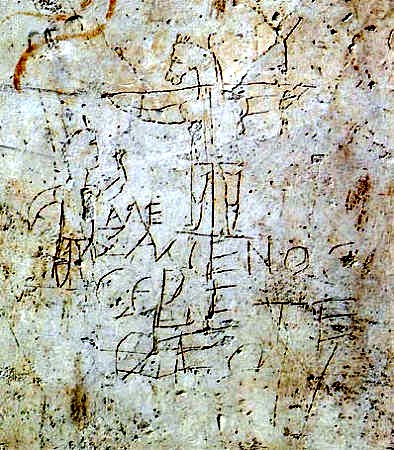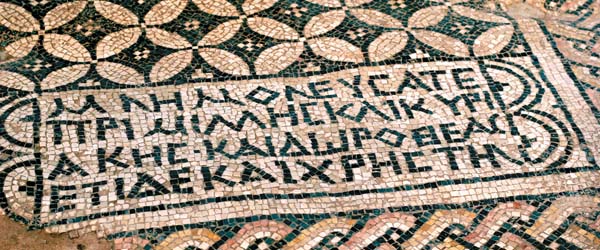
Evidence From Secular (non-Christian) Sources That Affirm The Crucifixion
Archaeological evidence for the crucifixion is rare, not only because evidence for a peasant being executed would be scarce, but although the ancient Jewish historian Josephus and Appian refer to the crucifixion of thousands of people by the Romans, there is only a single archaeological discovery of a crucified body dating back to the Roman Empire around the time of Jesus. Nonetheless, here are some convincing artifacts, and testimonies especially since they are from Anti-Christian Sources.
The Alexamenos Graffito
This piece of graffiti, from near the Palatine Hill in Rome and rather roughly dated to late in the second-century AD[16], was apparently drawn by one Roman soldier to mock the faith of a fellow soldier who was a Christian. It shows a man standing by a crucifixion victim with the head of a donkey. The Greek caption reads: “Alexamenos worships [his] God”.
This find is relevant because it is a non-Christian verifying the crucifixion of Christ as an historical event. The graffiti may depict the actual soldier or another soldier spoken of in Matthew 27:24
Now the centurion, and those who were with him keeping guard over Jesus, when they saw the earthquake and the things that were happening, became very frightened and said, “Truly this was the Son of God!”

Christian Church At Megiddo c 230 AD
John Dickson reports that: “Megiddo is the site of the earliest church building yet found. This strategic trade city contains the remains of a Christian prayer hall dating to the third century. It contains three mosaic inscriptions pointing to its Christian use.” One Greek inscription, which refers to the table in the centre of the hall that was probably used for communion, states: “The God-loving Akeptous has offered the table to the God Jesus Christ”. The fish that adorn the centre of one of four mosaics in the hall are a Christian symbol – the word ichthys (Greek for fish): “is an anagram of the words Iesous Christos Theou Yios Soter: Jesus Christ, Son of God, Saviour”
This find is significant in that it shows the early church practice of the Lord’s Supper in Luke 22:19-20 which was instituted by Jesus to commemorate His death, burial and resurrection for all times in memoriam and celebration.
And when He had taken some bread and given thanks, He broke it, and gave it to them, saying, “This is My body which is given for you; do this in remembrance of Me.” And in the same way He took the cup after they had eaten, saying, “This cup which is poured out for you is the new covenant in My blood.
Luke 22:19-20
The apostle Paul demonstrates the post crucifixion church practicing this ordinance in 1 Corinthians 11:23-26
For I received from the Lord that which I also delivered to you, that the Lord Jesus in the night in which He was betrayed took bread; 24 and when He had given thanks, He broke it, and said, “This is My body, which is for you; do this in remembrance of Me.” In the same way He took the cup also, after supper, saying, “This cup is the new covenant in My blood; do this, as often as you drink it, in remembrance of Me.” For as often as you eat this bread and drink the cup, you proclaim the Lord’s death until He comes.
1 Corinthians 11:23-26

Written Testimony
Roman Sources:
Tacitus, a Roman historian, in his Annals, c. Ad 115, mentions the crucifixion of Christ as Roman Historical record.
“…Nero fabricated scapegoats-and punished…Christians (as they were popularly called). Their originator, Christ, had been executed in Tiberius’ reign by the governor of Judaea, Pontius Pilatus.”
Lucian, Greek satirist, second century AD, alludes to Christ:
“…the man who was crucified in Palestine because he introduced this new cult into the world…. Furthermore, their first lawgiver persuaded them that they were all brothers one of another after they have transgressed once for all by denying the Greek gods and by worshipping that crucified sophist himself and living under his laws.”
Mara Bar-Sarapion, Stoic Philosopher from the Roman Province of Syria. written after AD 73.
“What advantage did the Jews gain from executing their wise King? It was just after that that their kingdom was abolished….But Socrates did not die for good; he lived on in the teaching of Plato. Pythagoras did not die for good; he lived on in the statue of Hera. Nor did the wise King die for good; he lived on in the teaching which he had given.”
Jewish Sources
Josephus, Jewish historian (AD 37-100) wrote of Jesus:
“At this time there was a wise man called Jesus, and his conduct was good, and he was known to be virtuous. Many people among the Jews and the other nations became his disciples. Pilate condemned him to be crucified and to die. But those who had become his disciples did not abandon his discipleship. They reported that he had appeared to them three days after his crucifixion and that he was alive. Accordingly, he was perhaps the Messiah, concerning whom the prophets have reported wonders.”
The Jewish Talmud (Centuries of Jewish oral tradition committed to writing between AD 200 and AD 500):
“On the eve of Passover they hanged Yeshu (of Nazareth) and the herald went before him for forty days saying (Yeshu of Nazareth) is going to be stoned in that he hath practiced sorcery and beguiled and led astray Israel. Let everyone knowing aught in his defense come and plead for him. But they found naught in his defense and hanged him on the eve of Passover.”